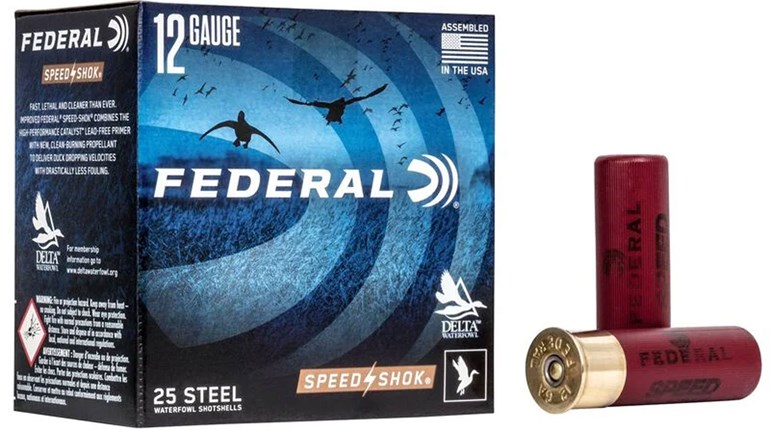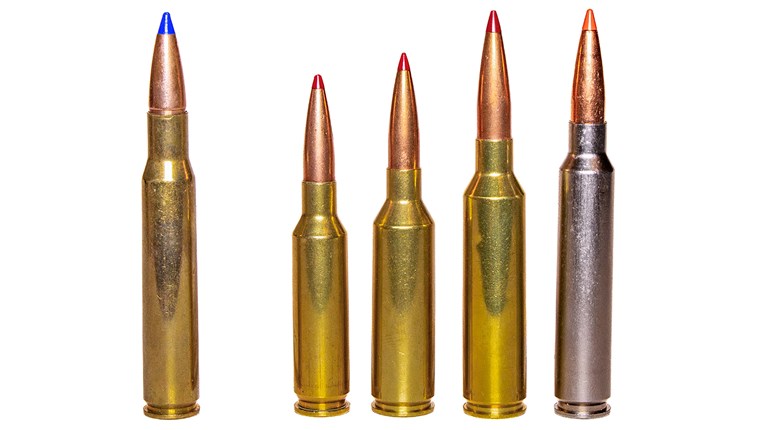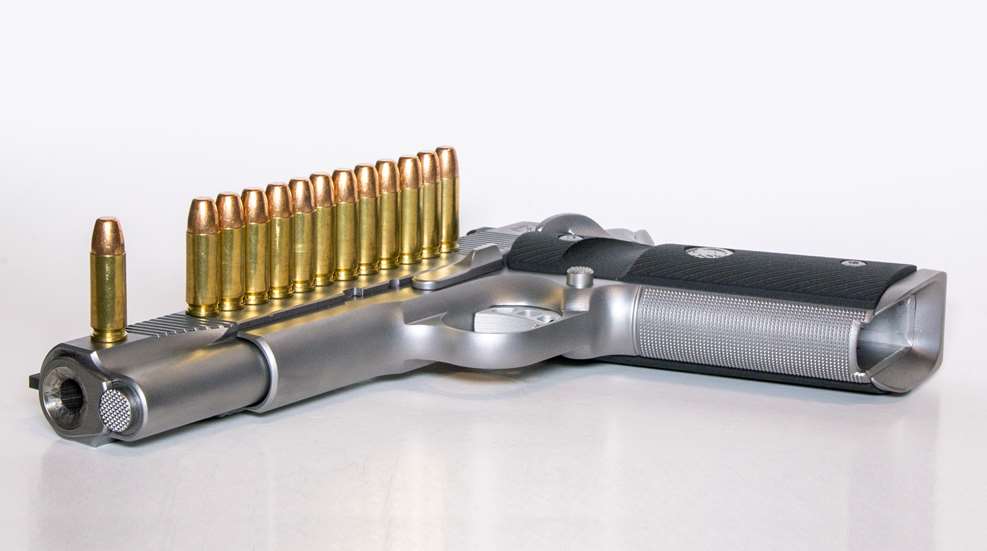
The 9 mm is the most popular handgun cartridge in the world for military, law enforcement and self-defense use. It’s been with us for 120 years. You’d think that as popular as self-defense firearms and concealed carry have become, after more than a century we’d have a newer/better option. Maybe that time has come: Federal has taken a bold step to introduce a new pistol cartridge specifically for concealed carry and self-defense. It’s called the 30 Super Carry.
Throughout history, handgun cartridges commonly used for hunting, competition, recreation and self-defense were originally designed for military or law enforcement applications. The new 30 Super Carry is, at least as far as I’m concerned, the first serious pistol cartridge of the last 100 years purposely designed to address concealed-carry needs. Federal’s goal was to create a cartridge that offered higher capacities in compact pistols without increasing size, but at the same time deliver a proven level of terminal performance with a recoil-impulse manageable by most shooters.
Admittedly, that’s a lofty goal, but one Federal seems to have achieved. I’m very optimistic about the concept, partly because I’ve always liked the .327 Fed. Mag. What does the .327 have to do with the 30 Super Carry? You could argue the 30 Super Carry is a semi-automatic version of the .327, because both utilize a .313-inch-diameter bullet and both are loaded to the same pressure. I was made aware of the 30 Super Carry more than a year ago, and have been excited ever since. I have a great deal of experience with the .327 Fed. Mag.; I’ve carried one off and on for 14 years and have taken several deer with it. The potential of a semi-automatic pistol cartridge approximating .327 Fed. Mag. terminal performance, while offering increased capacity beyond the 9 mm, was clear.
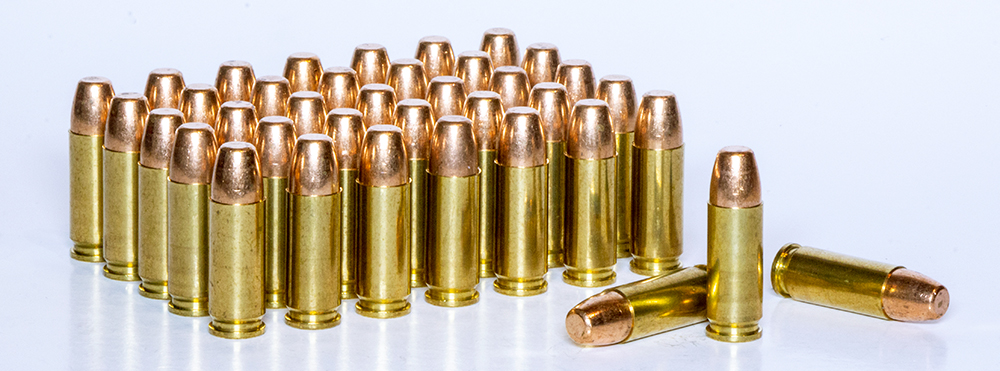
Federal provided me with 300 rounds of ammunition consisting of four different loads that included the Federal 100-grain HST, Speer 115-grain Gold Dot, American Eagle 100-grain FMJ and CCI 115-grain TMJ. In addition to these loads, which are already in production, Remington will be offering a 100-grain JHP and a 100-grain FMJ load.
For testing this new cartridge, Federal worked with Nighthawk Custom, and provided me a 5-inch 1911. Before offering the common cliché that the 30 Super Carry, “is an answer looking for a problem,” you should take the time to learn exactly what it is, and what it’s capable of.
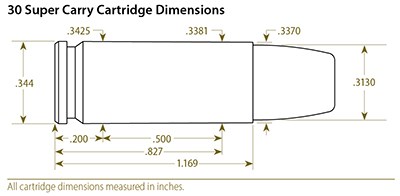 Dimensions
Dimensions
Based on the dimensions submitted to SAAMI, the 30 Super Carry fires a .313-inch-diameter bullet. The 9 mm fires a .355-inch-diameter bullet. That’s a difference of .042-inch, which is less than the thickness of a dime. The 30 Super Carry’s case is .827-inch long. A 9 mm cartridge case is .754-inch long. The 30 Super Carry’s rim is .344 inch in diameter and a 9 mm case has a rim diameter of .394. SAAMI approval of the 30 Super Carry is expected in June of 2022, at which time it is likely other manufactures will offer ammunition and firearms. To put these case dimensions in better perspective, a 9 mm magazine for a full-size 1911 will hold 10 rounds, and a 1911 magazine for the 30 Super Carry will hold 12.
While 1911-style pistols remain popularfor concealed carry, the real advantage the 30 Super Carry will offer is with double-stack magazines. To contain 10 rounds, a double-stack 9 mm magazine must have an inside width of .728 inch and a rear surface area of at least 1.56 square inches. By contrast, a double-stack 30 Super Carry 11-round magazine only needs an inside width of .639 inches, with a rear surface area of 1.31 square inches. Therefore, an 11-round 30 Super Carry Magazine is shorter and thinner than a 10-round 9 mm magazine. Given magazines of the same size, the 30 Super Carry magazine will hold up to 20-percent more ammo than a 9 mm magazine. But, because the 30 Super Carry magazine can be thinner, guns specifically built for it could also have a thinner grip.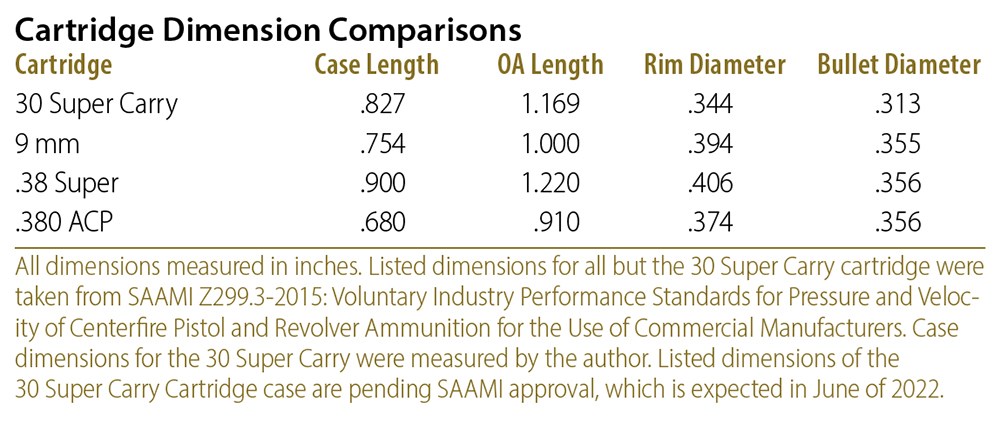
Internal Ballistics
The .327 Fed. Mag. can achieve external and terminal ballistics approaching that of the .357 Mag. because it’s loaded to a higher pressure—.357 Mag. ammunition is loaded to a maximum average pressure (MAP) of 35,000 psi. The MAP for the .327 Fed. Mag. is 45,000 psi. That’s a 28 percent difference. The 30 Super Carry is also loaded to 45,000 psi, with the same 28 percent pressure advantage beyond the 9 mm (which is also loaded to a MAP of around 35,000 psi).
This is high pressure for a semi-automatic pistol; the .357 SIG is only loaded to a MAP of 40,000 psi, for example. But this pressure is what allows the 30 Super Carry to reach the velocities it can, while delivering terminal performance comparable to a 9 mm.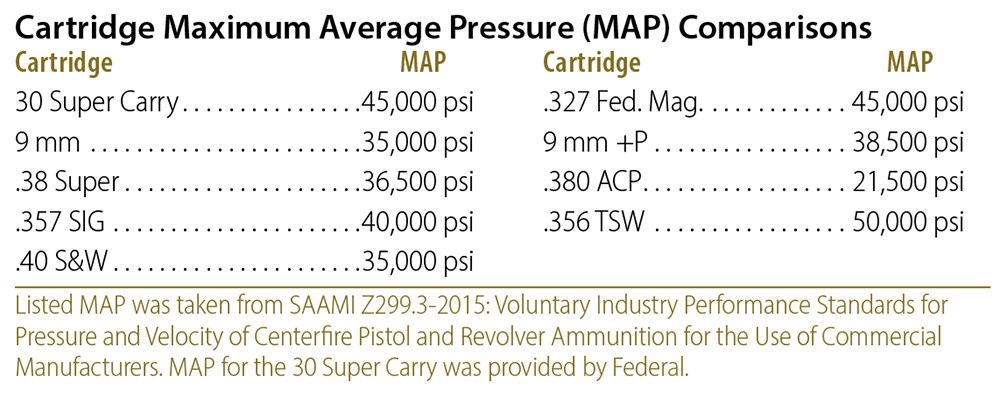
External Ballistics
Federal advertises its 30 Super Carry 100-grain loads with a muzzle velocity of 1,250 fps and 115-grain loads at 1,150 fps. Federal offers a 115-grain personal-defense load for the 9 mm in its Train + Protect line at 1,180 fps, but I think a better comparison would be Speer’s load, which has a listed muzzle velocity of 1,210 fps. Most 115-grain JHP 9 mm loads will have a similar velocity. This means when like-bullet weights are compared at advertised factory velocities, the 9 mm will have about a 50-fps advantage.
Does the 30 Super Carry live up to its advertised velocities? It appears so. Three of the loads tested in a 5-inch barrel produced velocities about 30 fps faster than advertised velocities that, according to Federal, were obtained with a 4-inch barrel. The 100-grain American Eagle FMJ load was the outlier, averaging 1,415 fps—165 fps faster than advertised. So, while there are always velocity variations from gun to gun, the new cartridge should live up to advertised velocities.
Terminal Ballistics
There are all sorts of ways to make terminal-performance comparisons. Some like to cite kinetic energy, others look at penetration and some believe bullet upset is key. The truth contains a little bit of all of those factors. Another truth is that minimal variations in terminal performance are hardly noticeable in the real world. But, what cannot be denied is that without sufficient penetration, little else will matter. This is why the FBI established 12 to 18 inches of penetration as a benchmark, so let’s start there.
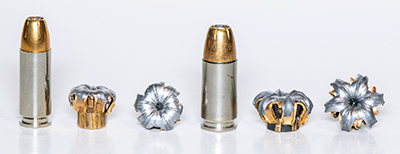
The 100-grain HST load averaged 13 inches of penetration into a block of Clear Ballistics (which is not what the FBI uses, but a fair substitute for our purposes) for five shots. The 115-grain Gold Dot load averaged 15.5 inches. Federal lists the penetration of these loads at 12- and 13.85-inches respectively in 10-percent ordnance gelatin (which is what the FBI uses). Regarding bullet upset, the HST load averaged a recovered diameter of .51 inch and the Gold Dot .55 inch. In 10-percent ordnance gelatin, Federal says to expect recovered diameters to between .56 and .59 inch. Experience has shown it’s common to see slightly less expansion and more penetration in Clear Ballistics than in 10-percent ordnance gelatin, so this all tracks as it should.
But what does this mean when compared with the 9 mm? Having tested many 9 mm loads, I believe the best are of the 124-grain variety. So, I tested the 9 mm 124-grain HST and Gold Dot loads in the same Clear Ballistics blocks. The 30 Super Carry had a slight edge in penetration and the 9 mm had a slight edge in expansion, but all loads met the FBI penetration minimum, albeit in a slightly different test medium.
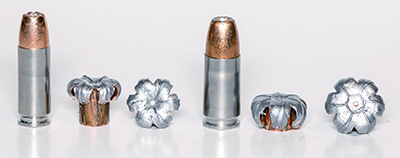
One way to balance these comparisons is to look at crush cavities, which is the hole the bullet makes based on its upset diameter and penetration depth. The average crush-cavity volume for the two 30 Super Carry loads was 3.16 cubic inches. The average for the two 9 mm loads was 3.17 cubic inches. I doubt even the most experienced forensic medical examiner could differentiate between 9 mm and 30 Super Carry wounds.
What about kinetic energy? Given the energy levels produced by self-defense pistol cartridges, it’s mostly irrelevant; the energy is used to deform the bullet and deliver it to a certain depth. But for those interested, the 124-grain 9 mm loads produced about 10 percent more energy at impact. Maybe more important, and something that seems to influence the size of the small temporary cavity cartridges in this category create, is the degree of bullet upset, often referred to as expansion factor. On average, the bullets from the 30 Super Carry deformed to 1.68 times their original diameter and the 9 mm bullets deformed to 1.61 times original diameter. Again, an inconsequential difference.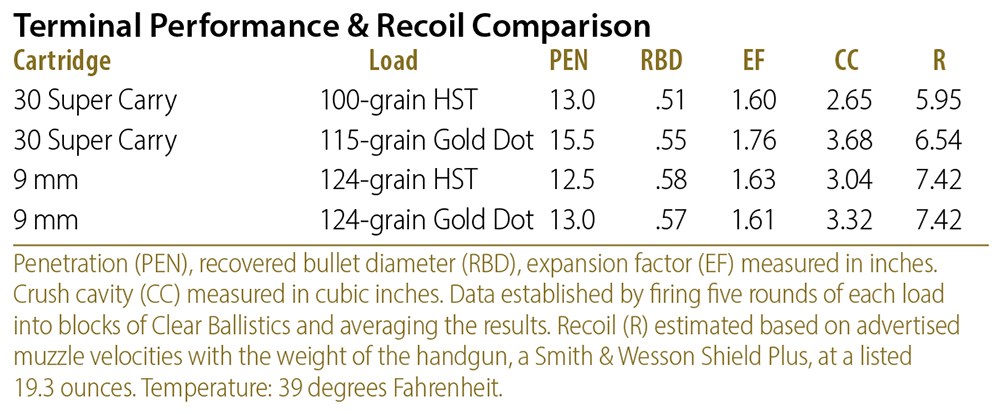
Precision/Accuracy
Accuracy, or precision on target, needs to be addressed, but it’s not that critical. I say this because I don’t remember the last time I tested a self-defense handgun that did not provide a level of precision fully sufficient for personal protection. Additionally, the gun used to test the 30 Super Carry was a match-grade, semi-custom 1911. I fired several five-shot groups off-hand at 10 yards, all on one side or the other of an inch. History has shown that .32-caliber handgun cartridges generally deliver excellent accuracy. The .32 H&R Mag. and .327 Fed. Mag. have carried on that tradition, which was started by the .32 Long, and I expect the 30 Super Carry will as well, outshooting anyone who lays hands on it.
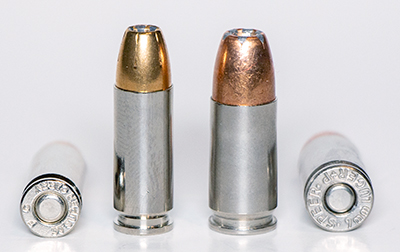
Is it Super?
What we now have with the 30 Super Carry is a cartridge that competes very well with the 9 mm from a terminal-performance standpoint, but with about 16 percent less recoil in similar-size handguns. (Recoil calculations were based on advertised velocities.) How important is recoil? I ran several multi-shot defensive-handgun drills with a 5-inch Wilson Combat 1911 in 9 mm and the 5-inch Nighthawk Custom 1911 in 30 Super Carry. On average, I was able to complete the drills with the 30 Super Carry 7.2 percent faster.
All things considered, if I only had one shot to stop a bad guy, I’d prefer the 9 mm, partly because of its proven track record, but also because of the wide array of munitions available for it. But, the totality of self-defense with a pistol is more than just about a single shot. The 30 Super Carry offers capacity and recoil advantages. Since the cartridge’s launch, Smith & Wesson introduced its 19.3-ounce M&P Shield Plus in 30 Super Carry. It will have 20 percent more capacity than the 9 mm version. If guns were built around the 30 Super Carry rather than just chambering it in existing pistols, they could be even smaller. This means easier to carry and conceal, while still delivering great terminal performance.
That’s why the 30 Super Carry matters now, and may matter even more in the future. Finally, those who carry concealed have a cartridge explicitly designed for that purpose.













